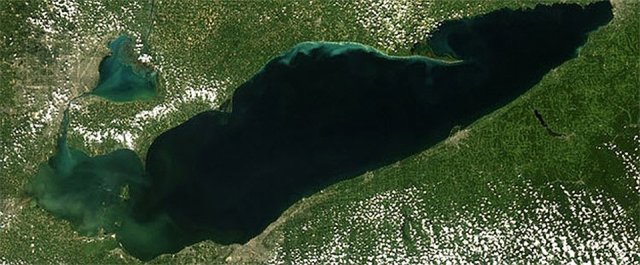EPA Researchers Study What Causes Agricultural Nutrients to Move into Waterbodies of the Midwest

Published December 14, 2021
Phosphorus and nitrogen are essential nutrients to people, animals, and plant growth. They occur naturally in the environment at low levels; however, they can also occur in high levels when introduced through sources like agriculture. When excess nitrogen and phosphorous used in fertilizers and manure seep from agricultural fields into watersheds, they can impact larger waterbodies by increasing algae growth. This can result in harmful algal blooms, which produce toxins that can negatively impact drinking water sources, aquatic species, and recreational water activities.
While there are many studies that focus on nitrogen and phosphorus losses, very few systematic reviews exist that aim to understand the impacts of site-specific conditions and management practices on annual nutrient losses in subsurface and surface runoff. To address these research gaps, EPA researchers gathered hundreds of peer-reviewed literature sources to conduct two studies that analyzed existing data from the Lake Erie Basin and 12 states in the greater Midwest U.S. These regions served as good research areas since the land is primarily used for crops – mainly corn, soybean, and wheat.
The first study analyzed factors that impacted dissolved reactive phosphorus losses from agricultural fields in the Lake Erie Basin. EPA researchers analyzed publications from 2000-2018 to identify the effectiveness of agricultural conservation practices and the correlation between these practices and dissolved reactive phosphorus losses in subsurface and surface waters. The analysis highlighted various factors, such as soil properties and crop systems, that can reduce excess nutrients from entering water bodies. For example, they found that soils with higher pH levels have more dissolved reactive phosphorus loss. They also found that higher precipitation levels and higher fertilizer application rates significantly increase dissolved reactive phosphorus loss.
The researchers also found that select agricultural conservation practices can significantly reduce nutrient and sediment loss at reasonable costs. For example, soybean crops can reduce dissolved reactive phosphorus runoff, while winter crops, such as wheat, can increase dissolved reactive phosphorus runoff. Additionally, no-till and conservation tillage increased dissolved reactive phosphorus loss compared to conventional tillage. Overall, the data showed that the effectiveness of agricultural conservation practice performance varies greatly, and further studies are necessary to better understand how different environmental and human factors affect nutrient loss.
The second study analyzed nutrient management strategies for water quality and crop yields and how those practices affect the loss of nitrate-nitrogen (i.e., nitrogen in the form of nitrate) from subsurface drainage in a dozen Midwest states. The researchers gathered data through literature screenings and data extraction from publications ranging from 1980 to 2019. This data contained detailed information about a variety of factors, including fertilization, corn yields, precipitation, drainage volume, and concentration loads. EPA researchers also analyzed how different fertilizer sources (i.e., organic and inorganic), and fertilizer application rates (i.e., low to high) and methods (i.e., incorporated, injected, surface applied) affect nitrogen loss into subsurface drainage flow.
After conducting the analyses, EPA researchers found that fertilizer rate was the most important factor that controls nitrate-nitrogen concentrations. Fertilizer rates vary from low to very high concentrations of either nitrogen or phosphorus application per acre to enhance crop growth. EPA researchers found that the use of organic fertilizers can significantly increase nutrient losses and that nitrogen content in manure varies highly. They also conducted a cost-benefit analysis to determine the economic benefits of nutrient management plans along with their environmental impacts. The researchers found that higher nitrogen fertilizer application rates can result in higher corn crop yields. However, after exceeding a certain application rate, more fertilizer doesn’t significantly increase corn yields but can significantly increase the nitrate-nitrogen losses in subsurface drainage discharge. Overall, the analysis shows that because local conditions and climate can vary greatly, it’s important to reevaluate nutrient management plans for nitrogen application.
“It’s important that water quality managers make informed decisions to better control nitrogen and phosphorus losses coming from agricultural fields,” said EPA researcher Yongping Yuan, who led the literature reviews. “Our research illustrates why current management strategies for non-point source nutrient reductions need to be further advanced to protect and meet the expected increased future demands on water for consumption, recreation, and ecological integrity.”
These literature analyses suggest that further efforts are required to produce effective nutrient management plans that minimize loss of phosphorus and nitrogen into surface and groundwaters. Going forward, the researchers will further investigate the effectiveness of agricultural conservation practices for nutrient reduction, such as cover crops and conservation tillage. They will also analyze if those practices are effective at reducing dissolved phosphorous loss, which is a key driver of harmful algal blooms in Lake Erie. Additionally, the researchers will analyze how agricultural conservation practices perform under extreme weather effects to better understand how climate change will impact nutrient management goals.
Learn More:
Agriculture Nutrient Management and Fertilizer
